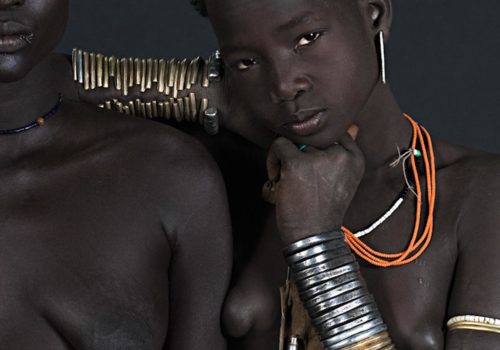Served by the sensuality and the delicacy of the large-format platinum prints, the black-and-white photographs of Isabel Muñoz are immediately recognizable. From series to series we see dances as different as the tango, flamenco, classical Cuban ballet and belly dancing, as well as bullfighters, Turkish wrestlers, flying Chinese monks and Brazilian capoeira fighters. These photographs, in their unaffected elegance, framed with an almost surgical precision, restore the idea of movement and communicate when we place them side-by-side, a fascination for questioning the eroticized body and the attention to the vibrations of light. Put simply, Isabel Muñoz is one of the most skillful and subtle photographers now working in black-and-white.
Outside the work she has done for magazines, Muñoz has also done important and little known work in color. By bringing the two series together, and by comparing the two printings techniques which apparently have nothing in common, we get a better glimpse of the nature of color for an artist who has never stopped exploring. The most spectacular series is of the Al Qadiriya in Iraq. These worshipers of Allah enter into a trance, escaping their bodies, feeling no pain as they swallow razor blades and walk on broken glass without apparent trauma. The way she is able to frame the fabric and flesh reminds one immediately of classical paintings in churches and museums, here served by classical photographic prints supporting the deep intensity of the colors and the stridence of a few crimson hues struck by light. Visually, these “fanatics” are no different from martyrs and other saints.
Opposite, the hieratic figures of the Surma and Omo of Ethiopia also enter into dialogue with painting. Firstly because these highland warrior-shepherds spend their time painting their bodies, inventing landscapes on their backs, transforming their faces and hands into writing, sometimes carrying simple and rich golden jewels and shells, wearing a simple, worn cover over themselves like an elegant shawl. The prints, part portrait and part details of bodies, allow for the colors to emerge gently from the texture of the skin. The dullness of the incredible color-plate prints lets all the subtleties of material and color, making you want to touch them, softens what could be decorative and frivolous about them and, paradoxically, intensifies the color effect. In these two series, color becomes the subject of the photograph, beyond what is represented. In both cases, the question is less of color photography than of photographing color.
Read the full article on the French version of L’Oeil de la Photographie.
EXPOSITION
Isabel Muñoz: “A todo color”
Du 4 septembre au 16 Novembre 2014
Centro Niemeyer
Avenida del Zinc, s/n,
33400 Avilés, Asturias
Espagne
















